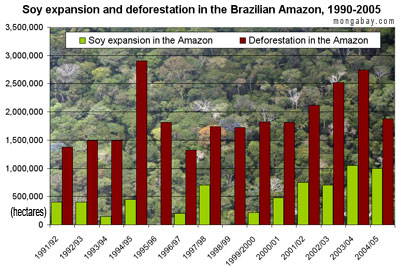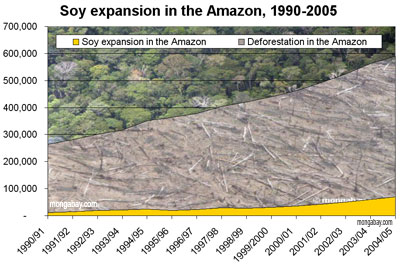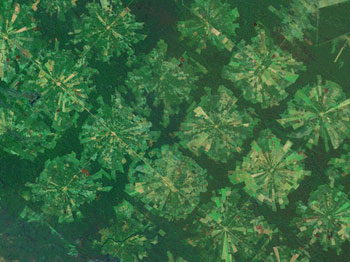728x90
The rapid expansion of soybean cultivation in the Amazon may be having a larger impact on climate than previously believed, according to research published last week in Geophysical Research Letters.
Using experimental plots in the Amazon, a team of scientists led by Marcos Costa from the Federal University of Viçosa in Brazil found that clearing for soybeans increases the reflectivity or albedo of land, reducing rainfall by as much as four times relative to clearing for pasture land.
"This [effect] is related to the surface radiation balance," explained Costa via email to mongabay.com. "Near the equator, rainfall is mainly produced by convective activity, that is, the hotter the surface the more rainfall you get. The soybean cropland, by having a higher albedo (reflectivity of the solar radiation) with respect to the original rainforest land cover, absorbs less energy, causing less convection and reduced rainfall."


Note: some soybean farms are established on already degraded rainforest lands and neighboring cerrado ecosystems. Therefore it would be inappropriate to assume the area of soybean planting represents its actual role in deforestation. |
"Soybean farms cause some forest clearing directly," said Dr. Philip Fearnside, a researcher at the Brazilian National Institute for Research in the Amazon (INPA) and a leading expert on the Amazon. "But they have a much greater impact on deforestation by consuming cleared land, savanna, and transitional forests, thereby pushing ranchers and slash-and-burn farmers ever deeper into the forest frontier. Soybean farming also provides a key economic and political impetus for new highways and infrastructure projects, which accelerate deforestation by other actors."
Fearnside says that improvement of BR-163 is a particular concern.
"BR-163, which is slated to be paved as an export corridor for soybeans via the Amazon River, traverses an area that is largely outside of Brazilian government control," he wrote in an Environmental Management paper. "A climate of generalized lawlessness and impunity prevails, and matters related to environment and to land tenure are especially unregulated. Deforestation and illegal logging accelerated in anticipation of highway paving. Paving would further speed forest loss in the area, as well as stimulate migration of land thieves (grileiros) to other frontiers."
 Agricultural clearing in the Amazon rainforest. Satellite image courtesy of NASA |
In recent years the Amazon has experienced the most severe droughts ever recorded. It is unclear as to what is causing these dry periods, though some scientists have suggested climate change could be an important factor. Some models suggest that higher carbon dioixde concentrations could increase temperatures in the Amazon by several degrees and turn much of the rainforest into savanna.
Related articles
A better way to cut down the Amazon rainforest?. A new study suggests that deforestation that follows a "fishbone" pattern may be less damaging from an environmental standpoint than traditional clear-cutting. The reason? Fishbone deforestation patterns may create conditions that increase precipitation levels which help cleared vegetation recover quicker
Expansion of agriculture in the Amazon may impact climate. A new study from NASA scientists shows that forest clearing for large-scale agriculture has recently become a significant cause of deforestation in the Brazilian Amazon. The researchers warn that this change in land use may affect the region's climate and the Amazon's ability to absorb carbon dioxide, a potent greenhouse gas.
Amazon deforestation rate plunges 41 percent. Today the Brazilian government announced a sharp drop in Amazon deforestation. Forest loss for the 2005-2006 year was 13,100 square kilometers (5,057 square miles) of rainforest, down more than 40 percent from last year. The figure is the lowest since 1991 when 11,130 square kilometers (4,258 square miles) of forest were lost. Last month the government announced 16,700 square kilometers (6,450 square miles) of forest had been lost this year, but revised the figures after additional data was analyzed.
Global warming could trigger 8-degree temperature rise in Amazon rainforest. Tuesday the Brazilian government announced the release of a series of scientific studies, including one by the national space agency (INPE) that projects a 4 to 8 degree-Celcius rise in temperatures in the Amazon Basin by 2100 if nothing is done to combat global climate change. The research, conducted by INPE scientist Jose Marengo, also warned of increasing probability of drought in the northeastern Amazon, with a 15-20 percent drop in rainfall under a pessimistic scenario.
Cargill busted in the Amazon rainforest. Brazilian authorities have shut down Cargill Incorporated's deepwater soy export terminal on the Amazon River reports the Associated Press. The action comes after a local judge ruled that the firm failed to prepare a proper environmental impact statement for the project.
CITATIONS:
- Costa, M. H., S. N. M. Yanagi, P. J. O. P. Souza, A. Ribeiro, and E. J. P. Rocha (2007), Climate change in Amazonia caused by soybean cropland expansion, as compared to caused by pastureland expansion, Geophys. Res. Lett., 34, L07706, doi:10.1029/2007GL029271.
- Fearnside, P.M. (in press). Brazil's Cuiabá-Santarém (BR-163) Highway: The environmental cost of paving a soybean corridor through the Amazon. Environmental Management. (in press) (accepted 22/09/06).
- Laurance, W.F., A.K.M. Albernaz, P.M. Fearnside, H.L. Vasconcelos and L.V. Ferreira. 2004. Deforestation in Amazonia. Science 304: 1109.
- Ravilious, K. (2007). Soybean boom spells bad news for climate. NewScientist | 21 April 2007
반응형
'庫間 > 해외자료' 카테고리의 다른 글
| 보존경운이 목화농사에서 석유와 흙과 수고를 아끼게 한다 (0) | 2012.08.07 |
|---|---|
| 프랑스 농부가 보존농업을 기대한다 (0) | 2012.08.07 |
| 스코틀랜드의 생태농업 계획에 대한 감축이 종의 상실로 이어질 수 있다 (0) | 2012.08.07 |
| 제초제 내성 풀이 늘어난다 (0) | 2012.08.03 |
| 소규모 종자생산 이야기 (0) | 2012.08.03 |


